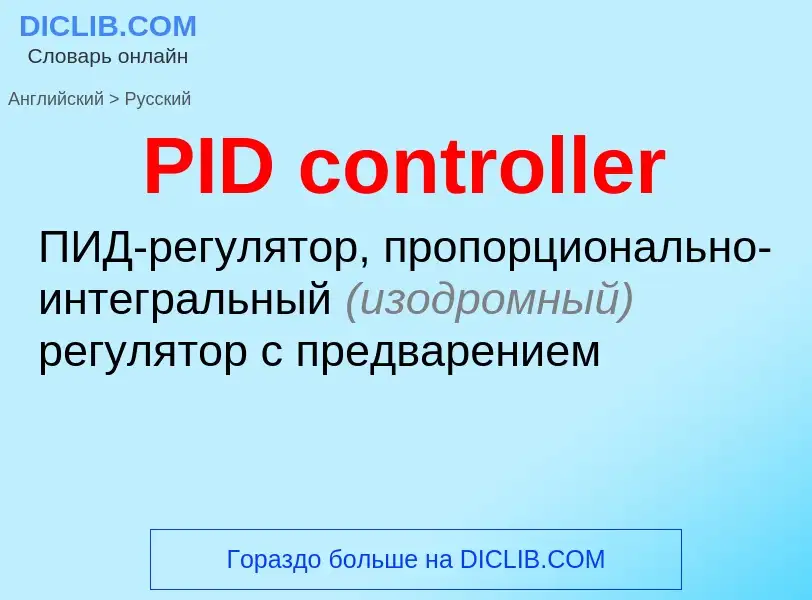Перевод и анализ слов искусственным интеллектом ChatGPT
На этой странице Вы можете получить подробный анализ слова или словосочетания, произведенный с помощью лучшей на сегодняшний день технологии искусственного интеллекта:
- как употребляется слово
- частота употребления
- используется оно чаще в устной или письменной речи
- варианты перевода слова
- примеры употребления (несколько фраз с переводом)
- этимология
PID controller - перевод на русский
строительное дело
ПИД-регулятор, пропорционально-интегральный (изодромный) регулятор с предварением
строительное дело
ПИД-регулятор, пропорционально-интегральный (изодромный) регулятор с предварением
общая лексика
дисковый контроллер, контроллер диска
плата расширения и/или микросхема, обеспечивающая взаимодействие процессора с дисковым накопителем
общая лексика
контроллер НГМД
['eəkəntrəulə]
синоним
['eətræfikkən'trəulə]
общая лексика
авиадиспетчер
авиационный диспетчер
Определение
Википедия
A proportional–integral–derivative controller (PID controller or three-term controller) is a control loop mechanism employing feedback that is widely used in industrial control systems and a variety of other applications requiring continuously modulated control. A PID controller continuously calculates an error value as the difference between a desired setpoint (SP) and a measured process variable (PV) and applies a correction based on proportional, integral, and derivative terms (denoted P, I, and D respectively), hence the name.
In practical terms, PID automatically applies an accurate and responsive correction to a control function. An everyday example is the cruise control on a car, where ascending a hill would lower speed if constant engine power were applied. The controller's PID algorithm restores the measured speed to the desired speed with minimal delay and overshoot by increasing the power output of the engine in a controlled manner.
The first theoretical analysis and practical application of PID was in the field of automatic steering systems for ships, developed from the early 1920s onwards. It was then used for automatic process control in the manufacturing industry, where it was widely implemented in pneumatic and then electronic controllers. Today the PID concept is used universally in applications requiring accurate and optimized automatic control.










![Early PID theory was developed by observing the actions of [[helmsmen]] in keeping a vessel on course in the face of varying influences such as wind and sea state. Early PID theory was developed by observing the actions of [[helmsmen]] in keeping a vessel on course in the face of varying influences such as wind and sea state.](https://commons.wikimedia.org/wiki/Special:FilePath/Scross helmsman.jpg?width=200)



![A setup disk of Japanese [[Microsoft Office]] 4.3, provided with 3.5" 1.2 MB and 1440 KB formats. A setup disk of Japanese [[Microsoft Office]] 4.3, provided with 3.5" 1.2 MB and 1440 KB formats.](https://commons.wikimedia.org/wiki/Special:FilePath/MS Office 4.3 Pro Japanese 1.44 MB floppy disk.jpg?width=200)

![Civilian air traffic controllers, [[Memphis International Airport]], 1962 Civilian air traffic controllers, [[Memphis International Airport]], 1962](https://commons.wikimedia.org/wiki/Special:FilePath/Civilian air traffic controllers, Memphis.jpg?width=200)
![Controllers often work from a control tower like this one at [[Birmingham Airport]], England Controllers often work from a control tower like this one at [[Birmingham Airport]], England](https://commons.wikimedia.org/wiki/Special:FilePath/Control tower at Birmingham Airport, England 27June2019 arp.jpg?width=200)
.jpg?width=200)
